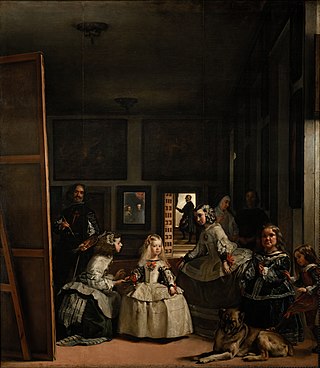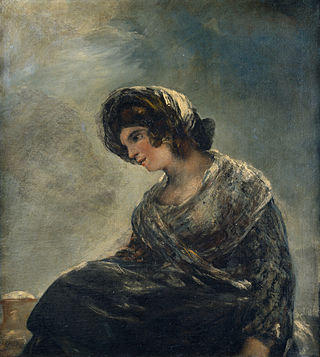
Francisco José de Goya y Lucientes was a Spanish romantic painter and printmaker. He is considered the most important Spanish artist of the late 18th and early 19th centuries. His paintings, drawings, and engravings reflected contemporary historical upheavals and influenced important 19th- and 20th-century painters. Goya is often referred to as the last of the Old Masters and the first of the moderns.

Diego Rodríguez de Silva y Velázquez, was a Spanish painter, the leading artist in the court of King Philip IV of Spain and Portugal, and of the Spanish Golden Age.

The Museo del Prado, officially known as Museo Nacional del Prado, is the main Spanish national art museum, located in central Madrid. It houses collections of European art, dating from the 12th century to the early 20th century, based on the former Spanish royal collection, and the single best collection of Spanish art. Founded as a museum of paintings and sculpture in 1819, it also contains important collections of other types of works. The numerous works by Francisco Goya, the single most extensively represented artist, as well as by Hieronymus Bosch, El Greco, Peter Paul Rubens, Titian, and Diego Velázquez, are some of the highlights of the collection. Velázquez and his keen eye and sensibility were also responsible for bringing much of the museum's fine collection of Italian masters to Spain, now one of the largest outside of Italy.

The Naked Maja or The Nude Maja is an oil-on-canvas painting made around 1797–1800 by the Spanish artist Francisco de Goya, and is now in the Museo del Prado in Madrid. It portrays a nude woman reclining on a bed of pillows, and was probably commissioned by Manuel de Godoy, to hang in his private collection in a separate cabinet reserved for nude paintings. Goya created a pendant of the same woman identically posed, but clothed, known today as La maja vestida, also in the Prado, and usually hung next to La maja desnuda. The subject is identified as a maja or fashionable lower-class Madrid woman, based on her costume in La maja vestida.

Spanish art has been an important contributor to Western art and Spain has produced many famous and influential artists including Velázquez, Goya and Picasso. Spanish art was particularly influenced by France and Italy during the Baroque and Neoclassical periods, but Spanish art has often had very distinctive characteristics, partly explained by the Moorish heritage in Spain, and through the political and cultural climate in Spain during the Counter-Reformation and the subsequent eclipse of Spanish power under the Bourbon dynasty.

The Real Academia de Bellas Artes de San Fernando, located on the Calle de Alcalá in the centre of Madrid, currently functions as a museum and gallery. A public law corporation, it is integrated together with other Spanish royal academies in the Instituto de España.

Charles IV of Spain and His Family is an oil-on-canvas group portrait painting by the Spanish artist Francisco Goya. He began work on the painting in 1800, shortly after he became First Chamber Painter to the royal family, and completed it in the summer of 1801.

The Goya Museum is an art museum located in Castres, France. The museum was originally established in 1840 and was named after the Spanish painter Francisco Goya since it has been specialised in hispanic art, since 1947.

The Milkmaid of Bordeaux is an oil-on-canvas painting completed between 1825 and 1827, generally attributed to the Spanish artist Francisco Goya (1746–1828). This painting is believed to be one of Goya's last works, completed the year before his death, and considered one of Goya's masterpieces.

The Inquisition Tribunal, also known as The Court of the Inquisition or The Inquisition Scene, is a 46-by-73-centimetre oil-on-panel painting produced by the Spanish artist Francisco Goya between 1812 and 1819. The painting belongs to a series which also includes Bullfight, The Madhouse and A Procession of Flagellants, all reflecting customs which liberals objected to and wished were abandoned, but their reform was opposed by the absolutist (autocratic) policy of Ferdinand VII of Spain.
Las Meninas is a series of 58 paintings that Pablo Picasso painted in 1957 by performing a comprehensive analysis, reinterpreting and recreating several times Las Meninas by Diego Velazquez. The suite is fully preserved at the Museu Picasso in Barcelona and is the only complete series of the artist that remains together. This is a very extensive survey work, which consists of 45 performances of the original picture, 9 scenes of a dove, 3 landscapes and a portrait of Jacqueline.

Self-Portrait with Dr Arrieta is the English title given to a painting by Spanish artist Francisco Goya. The work is an oil on canvas, painted in 1820, and is currently held in the Minneapolis Institute of Art, Minnesota. Many scholars have seen religious themes in the work. Other interpretations compare and contrast the painting with Goya's series of Black Paintings, contextualizing the work within his career at large.
Jonathan Mayer Brown was an American art historian, known for his work on Spanish art, particularly Diego Velázquez. He was Carroll and Milton Petrie Professor of Fine Arts at New York University.
José Luzán, also José Luzán y Martínez, was a Spanish Baroque painter.

Manuel Osorio Manrique de Zúñiga is a large full-length portrait in oil painted in 1787–88 by the Spanish artist Francisco Goya. It depicts a boy three or four years of age, standing in red clothes, with birds and cats. It is also known as Goya's "Red Boy". It was described by art historian Claus Virch in 1967 as "one of the most appealing and successful portraits of children ever painted, and also one of the most famous". The painting has been held by the Metropolitan Museum of Art, in New York, since 1949.

The Portrait of Doña Antonia Zárate is an 1810–1811 painting of the actress Antonia Zárate by Francisco Goya or his studio. It is now in the Hermitage Museum, and if it is an autograph work, it is the only painting by Goya in a Russian collection.

The Spanish royal collection of art was almost entirely built up by the monarchs of the Habsburg family who ruled Spain from 1516 to 1700, and then the Bourbons. They included a number of kings with a serious interest in the arts, who were patrons of a series of major artists: Charles V and Philip II were patrons of Titian, Philip IV appointed Velázquez as court painter, and Goya had a similar role at the court of Charles IV.

William Bryan Jordan Jr. was an American art historian who facilitated acquisitions, curated exhibitions, and authored publications on Spanish artists and still life paintings, particularly from the Golden Age.

Self-Portrait at 69 Years is an oil painting by the Spanish painter Francisco Goya. Two original versions of this work have been preserved. One of the paintings, painted on canvas, is housed in the collections of the Prado Museum. The other, created on wood panel, is located in the Real Academia de Bellas Artes de San Fernando in Madrid. Both paintings were created in 1815, in the post-war period, and depict a very similar image of the artist. This is one of the most sincere and direct self-portraits of the painter.

Don Juan and the Commendatore is a painting by the Spanish artist Francisco Goya. It belongs to a series of six cabinet paintings, each approximately 43 × 30 cm, with witchcraft as the central theme. The paintings do not form a single narrative and have no shared meaning, so each one is interpreted individually. The entire series was owned by the Dukes of Osuna and adorned their summer residence in Alameda de Osuna. In addition to Don Juan and the Commendatore, the series includes Witches' Sabbath, Witches' Flight, The Incantation, The Bewitched Man, and The Witches' Kitchen. Four of these paintings are housed in various public collections, one in a private collection, and Don Juan and the Commendatore is considered lost.

















